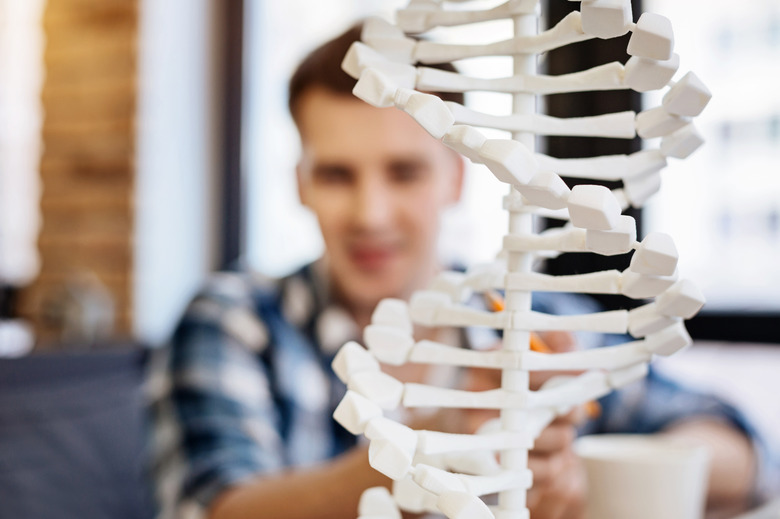How Did Watson And Crick Determine Base Pairing?
In 1953, two scientists named James Watson and Francis Crick solved a monumental puzzle. They discovered the structure of a molecule called deoxyribose nucleic acid — or as most people know it — DNA. Almost all living organisms, including humans, rely on DNA to package and copy genes. While scientists suspected this before 1953, they did not yet know how DNA copied itself or packaged heredity information. The key to DNA's ability to divide and copy itself was also the key to Watson and Crick's breakthrough: the discovery of base pairs.
TL;DR (Too Long; Didn't Read)
James Watson and Francis Crick developed models using cardboard cutouts that helped them discover base pairs serendipitously through trial and error.
The Structure of DNA
The Structure of DNA
Imagine the DNA double helix model as a twisted ladder with a frame made of a compound called sugar-phosphate. The rungs of the ladder consist of compounds called nucleotides, or bases. There are four bases in the DNA molecule: adenine, cytosine, guanine and thymine. In each rung of the ladder, two of the four nucleotides bond together with a hydrogen bond. These are the base pairs. The particular sequence of base pairs in a DNA molecule is what accounts for differences in genetic traits.
Rosalind Franklin and the Double Helix
Rosalind Franklin and the Double Helix
While Watson and Crick studied DNA structure, a scientist named Rosalind Franklin developed a successful method for taking X-ray photographs of DNA. Her images revealed two perpendicular lines creating a crisscross shape in the center of the molecule. When Franklin left her position at King's College, she left her photographs with a colleague named Maurice Wilkins. Shortly after, Wilkins gave these items to Watson and Crick. As soon as Watson saw Franklin's photographs, he understood that the crisscross shape meant the DNA molecule must be a double helix. But their breakthrough was far from complete.
A Serendipitous Discovery of Base Pairing
A Serendipitous Discovery of Base Pairing
Watson and Crick knew that DNA contained four bases, and that they bonded with each other in some way to create the double helix shape. Still, they struggled to conceptualize a model of DNA that was smooth and without strains — one that made biochemical sense. Watson built cardboard cutouts of the bases, and spent time rearranging them on a table to help him imagine possible structures. One morning, moving the pieces around, he stumbled upon an arrangement of bases that did make sense. Years later, Crick described this pivotal moment as happening "not by logic but by serendipity."
The researchers realized that when adenine and thymine bonded with each other, they formed a ladder rung the same exact length as a rung made of a cytosine-guanine pair. If all the rungs consisted of one of those two pairs, they would all be the same length, which would prevent the strains and bulges in the double helix that Watson and Crick knew could not exist in the real molecule.
DNA Replication
DNA Replication
Watson and Crick reasoned that if each of the four bases could only bond with one other base, then the DNA molecule could copy itself quickly during replication. In their 1953 publication on their findings in Nature magazine, they wrote "...if the sequence of bases on one chain is given, then the sequence on the other chain is automatically determined." Watson and Crick's double helix model of DNA launched an ongoing revolution in the life sciences, and is responsible for innumerable advances in fields of study such as:
- genetics
- medicine
- evolutionary biology
Cite This Article
MLA
E., Rebecca. "How Did Watson And Crick Determine Base Pairing?" sciencing.com, https://www.sciencing.com/how-did-watson-and-crick-determine-base-pairing-13710250/. 27 March 2018.
APA
E., Rebecca. (2018, March 27). How Did Watson And Crick Determine Base Pairing?. sciencing.com. Retrieved from https://www.sciencing.com/how-did-watson-and-crick-determine-base-pairing-13710250/
Chicago
E., Rebecca. How Did Watson And Crick Determine Base Pairing? last modified March 24, 2022. https://www.sciencing.com/how-did-watson-and-crick-determine-base-pairing-13710250/
